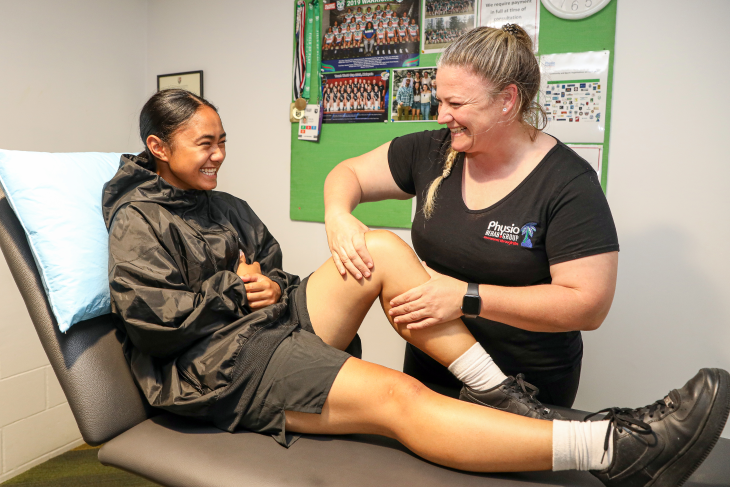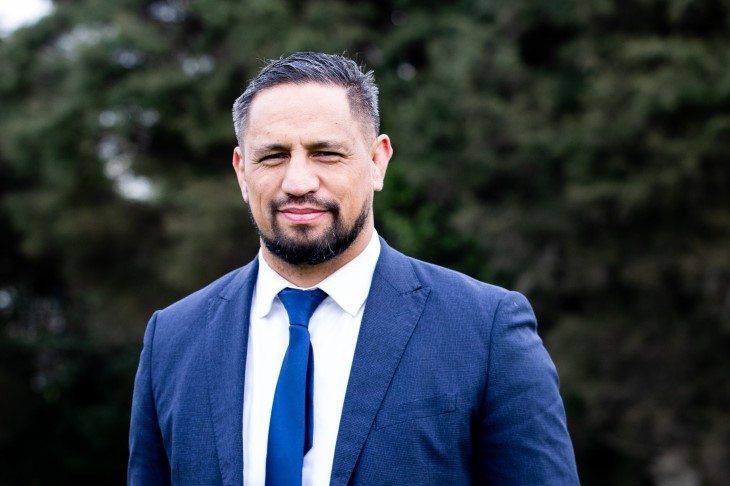Tina’s story: Back in touch after a serious injury Te kōrero a Tina: Kua hoki anō ki te pā whutupōro i muri i te wharanga kino

Te Tai Tokerau kuia loves nothing more than being the wahine with the whistle. The grandmother to 10 mokopuna suffered a serious injury while refereeing touch rugby in 2016. She is encouraging Māori to put up their hands for the help and support they need
Tina Koni is hobbling around at her aunt’s place in Putaruru using a broomstick to help her walk.
The then 56-year-old from Kaikohe is trying to shake off a knee injury, but it’s not coming right. She’s in a lot of pain.
“I guess I’m like a lot of Māori,” she says. “I don’t want to make a fuss. I just want to get on with it and I thought it would be sweet… but I needed help.”
Her aunt found the whole situation quite comical. “She could see that I was in agony,” says the 62-year-old. “She found it pretty funny that I was using a broomstick to walk, so I was trying not to laugh. I felt like I had been shot in the knee.
“It was time to go to hospital.” Tina (Ngāpuhi) is not alone when it comes to seeking help.
Our research tells us that Māori are less likely to seek our help for more minor injuries and overall, have lower claim rates. Our data shows Māori are 2.5 times more likely to experience a serious injury, but less likely to make an ACC claim (by around 20 percent).

Credit Shane Wenzlick
There are also a range of barriers to Māori seeking ACC’s help following an injury.
These include not thinking the injury is serious enough to get help, not knowing what ACC covers, and not thinking that ACC will help them. “We acknowledge this inequity,” says Michelle Murray, our Tumu Pae Ora.
“We have set the stage for increased trust and meaningful change – a new chapter in ACC’s relationship with Māori that has already begun.”
ACC has launched a campaign called Kia Mahea Kia Puawai (making it clear so we can flourish).
It’s a by-Māori for-Māori approach designed to improve access and knowledge around what support is available.
“It was a bit of a scene”
Tina suffered her knee injury while refereeing at the Māori National Touch tournament in Rotorua in 2016.
“It was a bit of a scene,” she says with a laugh. “It’s not often that a referee goes down with a serious injury. But you know, the game had to go on.”
Tina was in the middle of the field when she pivoted and ran backwards. Her foot caught in the ground and twisted her knee.
“I went down in a heap,” she says. “I was in a lot of pain. I tried to stand up because I was the lead referee at the time, but I just couldn't.”
Tina was helped from the field. The players surrounded her and poured water over her knee. Her left knee swelled up like a balloon. A volunteer worker on a St John Ambulance cart picked Tina up and took her back to the referees’ headquarters.
Tina was lined up to referee a semi-final, which she was disappointed to miss. “I had worked hard to be at that tournament. I sat there with an ice pack on my knee, and I knew I had some serious damage. I was gutted.”
Tina decided not to go to hospital straight away. “I hoped it would come right but it wasn’t getting any better.”
She was able to drive, so she headed off to Putaruru to see her aunt. She took one look at her and said we need to go the hospital.

Credit Shane Wenzlick
Going under the knife
Tina had ruptured her medial collateral ligament (MCL). She had the injury in December and went under the knife in April.
In the days following her surgery, Tina was tentative about getting back on her feet. “I was like ‘I've just had surgery I need to be careful’. I had this big bandage around my knee.
“But the specialist said no, we encourage you to get on your feet. The best way to get all the movement going on your knee is just start walking.”
She had to walk before she could run. It was a slow process but over time she developed confidence. At the same time New Zealand was hosting the America’s Cup which played a role in her rehabilitation.
“That was a real inspiration for me because I enjoyed watching the Team New Zealand grinders on their bikes and I was on my bike trying to keep up,” she laughs.
She says it was great to have the support of ACC so she could focus on her recovery. “They were awesome. Everything was there for me, and it was great to have that support.”
Tina works at the local Countdown supermarket and says it was a relief that her injury was not a financial burden for the whānau.
“I’ve got my own home, so I still had a mortgage to pay so that was pretty stressful. But to know that there was still money coming in and that the medical costs were covered, that was huge in my recovery.”

Credit Shane Wenzlick
Getting back on the touch field
The final step in Tina’s recovery was lacing up the boots and picking up the whistle again. Naturally she was nervous, but she trusted her physiotherapist’s advice.
“I was worried if my knee was going to stand up to it,” she says. “I had to get it into my mind that you don't have an injury anymore, you're all fixed. It was a mental shift for me."
Tina says a key part of getting back on the field was adopting the TouchFit360 warm-up. “Ever since my injury I know the importance of warming up properly,” she says.
“I do a dynamic warm up that is right for touch every time I ref. And every time I go to a national tournament, I do the TouchFit360 warm up. It’s the best way to get ready for a game.”
ACC invests in Touch NZ to deliver the TouchFit360 injury prevention programme. “Touch rugby has a unique ability to bring people together,” says James Whitaker our Injury Prevention Programme Leader.
“We are pleased to partner with Touch Rugby NZ as we look to prevent injuries across the country and help Kiwis to continue doing what they love.”
TouchFit360 works on conditioning for in-game movements such as contact, jumping, landing, and changing direction. It prepares touch players' bodies for training and matches and enhances performance. It decreases the risk of injury.
“It’s awesome and it works. I make sure the warmup I am doing is dynamic, so I am ready for the game.”
She recommends anyone playing touch rugby this season to build into the season. “We see it every year, people come back to the game after having the winter off. They go too hard too soon and get injured. You have got to know your limits.”

Credit Shane Wenzlick
Back in her happy place
Tina says it was hard to describe what the feeling was like coming back after a serious injury. “Oh man, it was so good,” she says. “I had worked pretty hard for that moment, and I haven’t looked back.”
Tina loves to control the game and earn the respect from the players. Being part of the referee whānau is special.
“I just love the game and being part of this community. I love to see the kids coming through and for them to grow their love of touch rugby.” Tina has travelled to Samoa three times to ref and went to the Fiji Cup Touch in November. It’s a privilege to be in that company.
And she has no plans to hang up the boots anytime soon. “I think my body will tell me when to stop. But as long as I'm still running, I'm going to keep going.”
For more about TouchFit360:
For more about accessing ACC:





